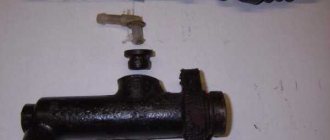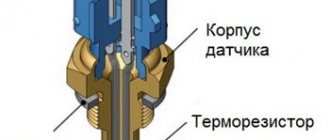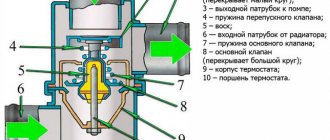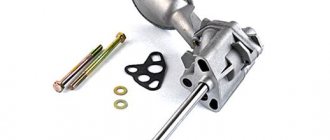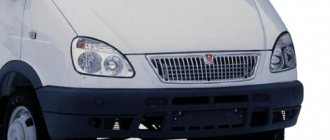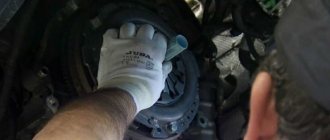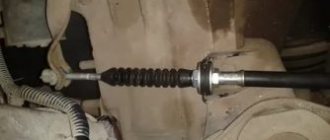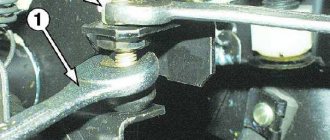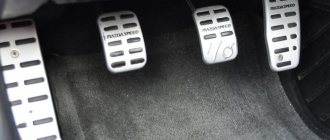October 29, 2015 Lada.Online 35 910 3
During the operation of the car, parts wear out, which ultimately leads to breakdown. Does the car start moving only at the very end of releasing the clutch pedal, has the traction disappeared or has extraneous noise appeared? Signs indicate that the clutch is faulty and should be repaired.
The main signs of a clutch failure.
On any car, the clutch wears out as it is used, and its operation begins to be worn out. Clutch diagnostics should be performed when the following signs are detected:
- On cars that have a manual transmission, the clutch “grabs” even if the pedal is in the top position. The higher it is, the more worn out the clutch is. This can be easily checked when driving the car.
- Decrease in dynamics. If the clutch discs slip, the power generated by the engine will not be fully transmitted to the gearbox and wheels. This problem is often accompanied by the smell of burnt rubber.
- Reduced dynamics when driving with a trailer. The problem here is the same as in the previous paragraph.
- When starting from a standstill, the car jerks. This may occur due to a damaged surface of the driven disk due to overheating. Overheating, in turn, can occur as a result of excessive force on the clutch part.
- The clutch "drives". This problem is the opposite of slippage, where the drive and driven discs do not fully disengage when the clutch is depressed. As a result, the driver has difficulty changing gears, and sometimes some, or even all, of them simply do not engage. Also, when switching, unpleasant sounds may be heard.
Not only do natural processes wear out the clutch, but improper operation of the vehicle also contributes to this. It should not be overloaded, tow trailers that are too heavy, especially when moving downhill, and you should not start with slipping. Such use leads to a critical operating mode of the clutch, due to which it may partially or completely fail. If at least one of the described symptoms is detected, the clutch must be checked. Driving a car with a faulty clutch not only causes discomfort, but also further worsens its technical condition, which leads to expensive repairs.
To ensure a high-quality clutch replacement, a number of factors must be observed:
- availability of professional equipment for diagnostics and repair, as well as the use of special tools in the work,
- sufficient qualifications and experience of auto mechanics with good skills in servicing/repairing vehicles of different brands based on the technical standards of automakers,
- use of original spare parts or certified non-original components made in Europe, and high-quality consumables.
The entire cycle of work on replacing the clutch is completed by the auto technicians of our technical services “H2O-Auto” in one day. As a rule, the following parts must be replaced: basket, clutch disc and release bearing, drive seals (for front-wheel drive vehicles), transmission oil and brake fluid, which is used to pump the clutch hydraulics. During the process of replacing elements, the mechanic checks the integrity and level of wear of the flywheel. Sometimes the contacts connecting the flywheel and clutch disc become oxidized due to overheating and become covered with microcracks. The tightness of the crankshaft oil seal is assessed. If it is unsuitable for further use, it is replaced with a repair kit. The dual-mass damper flywheel must also be inspected. This unit has a limited service life, therefore, if there is significant wear, it is replaced with a new one.
The procedure for replacing the clutch for front-wheel drive vehicles:
- preparing and dismantling the gearbox by disconnecting the wires going to the front pair of wheels,
- replacing the clutch basket and disc on the flywheel of the power unit,
- replacing the release bearing in the gearbox housing,
- installing the gearbox on the workplace in the reverse order, with a parallel check of the tightening torque of all fastening bolts and nuts,
- bleeding the clutch hydraulic system,
- changing oil and brake fluid,
- test running of the restored clutch.
On vehicles with isotronic-type robotic gearboxes, initialization (adaptation) of the grip point is carried out. In other words, the robotic transmission ECU remembers the parameters of the new clutch. This is a mandatory operation, because Without initialization, the robot may not detect the clutch. Owners of a car with a robotic gearbox should strictly adhere to the automaker's recommendations for servicing such gearboxes, and also carefully study useful tips for driving a vehicle equipped with an MMT gearbox (robot).
How to check the clutch?
To perform detailed diagnostics of the clutch system, you will need special equipment and the dismantling of some of its elements. But first, you can check it in four simple and effective ways.
Check in 4th gear.
For cars with manual transmission , there is a simple method for checking the performance of the clutch. Here you need to rely on the speedometer and tachometer arrows. Before starting the test, you need to find a flat road, about a kilometer long. Next you need to do the following:
- accelerate the car to 4th speed (60 km/h)
- then stop accelerating it and let the car slow down on its own;
- when the car begins to “choke”, at a speed of 40 km/h you should sharply press the gas;
- During acceleration, you need to monitor the speedometer and tachometer.
If the clutch is working properly, then their arrows will simultaneously move to the right, and if the discs are heavily worn, then when you press the gas, the engine speed and power will increase sharply, but the energy will not flow to the wheels. Simply put, the speed will increase too slowly, and the speedometer and tachometer needles will move differently. Also, with a sharp increase in the speed of the power unit, whistling sounds will be heard from it.
Checking on the handbrake.
This method can only be used if the handbrake is adjusted according to all rules. The sequence of actions is as follows:
- The car must be put in handbrake
- then you need to start the engine;
- now you need to squeeze the clutch and engage 3rd or 4th speed;
- Next you need to try to move away.
If the engine jerks and stalls, then the clutch is normal. But if the engine continues to run, then the clutch discs are worn out. They are not restored, but their position is adjusted or completely replaced.
External signs of wear.
The condition of the clutch when driving a car can be determined by driving downhill or with a load. When the clutch slips, a burning smell will most likely appear in the cabin, emanating from its basket. The same sign is a deterioration in the dynamics of the car during acceleration or driving downhill.
The clutch "drives".
This occurs when the driving and driven discs cannot fully open when the pedal is pressed. This usually causes difficulty when changing gears. Also, creaking and grinding noises are heard from the gearbox. To check the clutch in this situation, the following is required:
- you need to start the engine and leave it idling;
- then you need to fully depress the clutch;
- Now you need to engage 1st gear.
If the gear shifts easily and there are no extraneous sounds, then the clutch is normal. If difficulties arise, it means that the clutch disc is not disengaged from the flywheel, and this will lead to the already mentioned troubles. This problem can completely damage both the clutch and gearbox. This can be eliminated by bleeding the hydraulics or adjusting the clutch pedal.
The principle of operation of the clutch and its varieties
Clutch device: 1 – flywheel; 2 – driven disk; 3 – clutch casing with pressure plate; 4 – diaphragm spring.
The essence of the clutch system is the tight compression between the engine flywheel, clutch disc and pressure basket. In this simple way, torque is transmitted to the input shaft of the gearbox. Structurally, clutches can vary significantly in various parameters. It could be:
- single disk;
- multi-disc;
And if the first clutch option is the most common today, then the second is certainly the future. By working environment there are:
- dry clutch;
- wet grip;
A wet clutch is a system immersed in a special reservoir of oil, while a dry clutch operates without such support. There are other signs by which clutch systems in modern cars can be classified. But the thing is that while the clutch system works normally, few of the people driving a car think about the design and type of clutch they use. Well, when the clutch starts to falter, it will be impossible not to notice it.
How to check the clutch disc?
Before checking, you should know about its disk resource. The clutch is most susceptible to wear when driving around the city, which is due to frequent gear changes, braking and starting, and the average mileage is about 80,000 km. With such a mileage, it is worth checking the disc even if there are no external signs of wear.
The degree of disc wear can be determined by the thickness of the friction linings. You can recognize it by the movement of the clutch pedal, but first you need to adjust it correctly. You need to know that the required thickness of the linings differs for different brands and models of cars, and detailed information about this can be found in the documentation for the car. The free position of the clutch pedal is 1-2 cm higher than the depressed position of the brake pedal.
Disk wear is checked as follows:
- the car must be parked on a level surface;
- The “handbrake” needs to be removed, put in neutral and start the engine;
- now you need to press the clutch and shift the gearbox to 1st speed;
- Gradually depressing the clutch pedal, you should move away, but do not let the engine stall;
- at the beginning of the movement, you need to notice at what position of the clutch pedal the car begins to move;
- If vibration occurs, the procedure must be stopped.
The test results are:
- Starting the car with the clutch pedal pressed 30% indicates the serviceability of the disc. Usually this happens after replacing the disc and basket;
- When you start moving approximately in the middle position of the pedal, the disc is worn out by 40-50%. The clutch can be operated, but it will need to be checked again soon.
- If the clutch “grips” when the pedal is fully depressed or does not happen at all, then the disc is critically or completely worn out and needs to be replaced.
Also, severe wear of the disc is indicated by vibration of the car when starting from a stop, slipping of the clutch when driving downhill, when pressing the gas, when driving with a trailer.
How to check the clutch basket?
The signs of a basket problem are the same as those of the driven disk, that is, the dynamics deteriorate, the clutch slips , it is difficult to change gears, the car jerks when starting off. It often happens that if the basket is damaged, the gears stop shifting. To make sure that the basket is broken, you will have to remove it and carry out diagnostics. The most common basket problem is worn out petals. As a result of the loss of their properties, the pressing of the driven disk deteriorates.
When inspecting the petals, you need to pay attention to the following:
- The location of all petals should be the same and in the same plane, without bends or twists;
- Overheated petals often develop dark blue spots. This happens because the release bearing has failed, so you need to inspect that too.
- No less often, grooves from the release bearing are found on them. It is generally accepted that if they are evenly spaced and their depth is no more than the height of the petal, then this is the norm, although it means that the basket will need to be changed soon. If these grooves are of different depths, then the basket should be replaced as soon as possible, since it is not able to provide normal pressure.
- With a chaotic arrangement of spots from overheating, it makes sense to think about overheating of the basket. It has already lost some of its working qualities, so it is recommended to replace it. If the spots are located in a certain order, then this is natural wear of the part.
- The petals should not have cracks or other damage. Only slight natural wear of no more than 0.3 mm is acceptable.
- The basket pressure plate also needs inspection. If it is very worn, the basket should be replaced. You can check it with a ruler, placing it on the edge. In this way, you can determine the position of the disk relative to its plane. If there is a curvature of more than 0.08 mm, then the disk needs to be changed.
- If you have a dial indicator on hand that measures potholes, it can be used to determine the degree of wear on the drive disk. To do this, you need to fix the measuring rod on the disk, and the deviation during rotation should be no higher than 0.1 mm. If it is larger, then the disk needs to be replaced.
If the basket is seriously worn, then it is worth inspecting the release bearing and driven disk. More often than not, they also wear out significantly and it is recommended to replace them together. This, of course, will cost more, but the clutch will work properly and for a long time.
How to check the release bearing?
It only comes into operation when the pedal is depressed. In this case, the bearing moves back and pulls the driven disk. It is important to know that during operation, the bearing is subject to serious loads, so you should not keep the pedal depressed for a long time. This threatens its early breakdown. One of the most common signs of a broken release bearing is the formation of noise at its location when the clutch is depressed. This means that it is partially out of order. This option can be excluded in winter if noises are heard in the first minutes after turning on the engine. This can be explained by the difference in the expansion coefficients of the metal from which the bearing and the cup are made. If the bearing is in good condition, then after warming up the noise should disappear. Another sign of a broken release bearing is difficulty shifting gears, but this can also happen for other reasons. For example, it is difficult to engage a gear when starting from a stop, or the car jerks while driving, and the clutch does not work properly. In this case, you need to additionally check the release bearing, but with the gearbox removed.
How to check pedal free play?
The clutch pedal has a certain free play value. After some time or due to the influence of certain factors, this value may increase. First, it is necessary to determine this value at the moment, and if it deviates from the permissible norm, it is necessary to carry out appropriate repairs. Many cars are equipped with an adjustable clutch system, and you can adjust it either yourself or with the help of a specialist. If the car has only had minor mileage on its basket, then this repair method can solve the problems, but if it is serious and the clutch has already been adjusted, then replacing the discs or basket is recommended. Repairs and adjustments should be made when the first signs of a problem are detected, as this will save money on expensive repairs.
Avto.tatar specialization includes “ clutch replacement ”
What to do if the clutch is faulty
Alas, troubleshooting a car’s clutch usually comes down to replacing either the entire system or one of its components. It happens that you only need to replace the release bearing or the clutch disc, but sometimes you have to change everything. Another not particularly pleasant point is that only experienced motorists can change the elements of the clutch system in their garage. The vast majority of car owners have to go to a service station.
Well, perhaps the most unpleasant moment when there is a problem with the clutch system is the cost of replacing its elements. Especially for foreign-made cars. In any case, the costs will be significant and you need to be prepared for this.
What to do if a clutch malfunction catches you on the road? The answer, in general, is obvious - you need to go to a service station, since driving such a car will not work for any long time. But how do you get to a car repair shop if it’s not nearby and there’s no one to tow the car? To do this, there is a technique called double-clutch release. If we need to upshift, we first depress the clutch, shift to neutral, and release the clutch. Next, press the clutch pedal again, engage a higher gear and release the clutch. In the same case, when we need to switch to a lower gear, we again depress the clutch, switch to neutral, release the clutch, give the gas, depress the clutch, engage the desired gear and release the clutch pedal.
